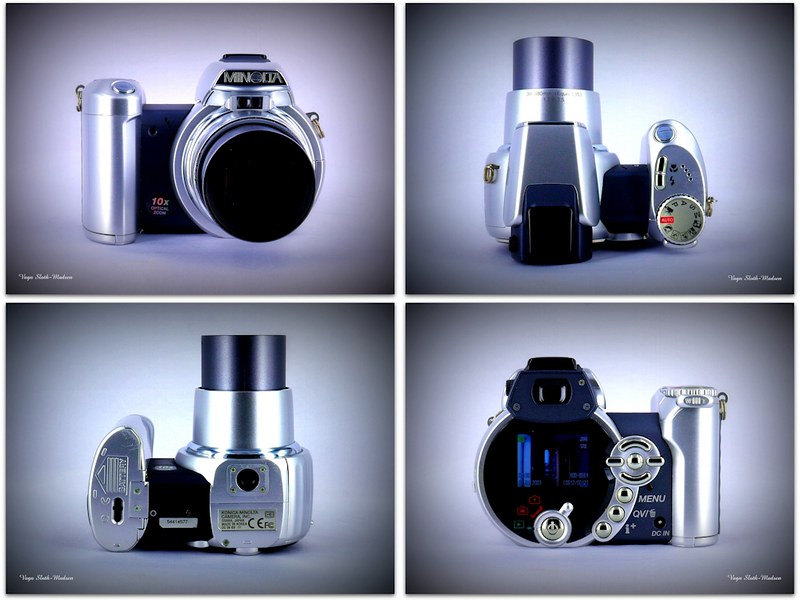Difference between revisions of "Minolta DiMAGE Z1"
(Created page with "The camera with the futuristic design was launched in September 2003, one month before Minolta's merger with Konica. Thus the first model of Konica Minolta's Z-ser...") |
Hanskerensky (talk | contribs) (Added link to user manual page) |
||
| (3 intermediate revisions by 2 users not shown) | |||
| Line 1: | Line 1: | ||
| − | The camera with the futuristic design was launched in September 2003, one month before [[Minolta]]'s merger with [[Konica]]. Thus the first model of [[Konica Minolta]]'s Z-series was a true [[Minolta]] model: The '''Minolta DiMAGE Z1'''. It was a ''super zoom'' camera with diopter-correctable [[EVF|electronic viewfinder]]. It had a 1/2.7" 3 [[Megapixel]] [[CCD]] [[sensor]]. It could take 4:3-format photos with up to 2.048×1.536 color [[pixels]] and color videos in [[VGA]] format 480×640, and could store that stuff on [[SD card]]s. It had a set of still phtotography exposure programs plus the complete [[PASM|P,A,S,M]] set of standard modes plus a fully automatic exposure mode, like most contemporary [[analog]] consumer [[SLR]]s. Thus it can be called a [[bridge camera]]. This camera type was especially important for [[Minolta]] fans since they had still to wait for the first consumer [[DSLR]] of 'their' | + | The camera with the futuristic design was launched in September 2003, one month before [[Minolta]]'s merger with [[Konica]]. Thus the first model of [[Konica Minolta]]'s Z-series was a true [[Minolta]] model: The '''Minolta DiMAGE Z1'''. It was a ''super zoom'' camera with diopter-correctable [[EVF|electronic viewfinder]]. It had a 1/2.7" 3 [[Megapixel]] [[CCD]] [[sensor]]. It could take 4:3-format photos with up to 2.048×1.536 color [[pixels]] and color videos in [[VGA]] format 480×640, and could store that stuff on [[SD card]]s. It had a set of still phtotography exposure programs plus the complete [[PASM|P,A,S,M]] set of standard modes plus a fully automatic exposure mode, like most contemporary [[analog]] consumer [[SLR]]s. Thus it can be called a [[bridge camera]]. This camera type was especially important for [[Minolta]] fans since they had still to wait for the first consumer [[DSLR]] of 'their' camera maker which was delivered by [[Konica Minolta]] the next year. |
The Z-series became a cash cow of [[Konica Minolta]]. | The Z-series became a cash cow of [[Konica Minolta]]. | ||
| Line 8: | Line 8: | ||
|image_align= left | |image_align= left | ||
|image_text= | |image_text= | ||
| − | |image_by= | + | |image_by= Vagn Sloth-Madsen |
|image_rights= wp | |image_rights= wp | ||
}} | }} | ||
| + | |||
| + | {{br}} | ||
| + | ==Links== | ||
| + | *[https://www.manualslib.com/products/Minolta-Dimage-Z1-1914347.html Minolta Dimage Z1 user manual] at [https://www.manualslib.com/ Manualslib] | ||
[[Category: Japanese digital]] | [[Category: Japanese digital]] | ||
[[Category: Minolta|Dimage Z1]] | [[Category: Minolta|Dimage Z1]] | ||
| − | |||
[[Category: M|Minolta Dimage Z1]] | [[Category: M|Minolta Dimage Z1]] | ||
| − | [[Category: D|Dimage Z1]] | + | [[Category:D|Dimage Z1 Minolta]] |
[[Category: Bridge camera]] | [[Category: Bridge camera]] | ||
Latest revision as of 07:35, 28 January 2022
The camera with the futuristic design was launched in September 2003, one month before Minolta's merger with Konica. Thus the first model of Konica Minolta's Z-series was a true Minolta model: The Minolta DiMAGE Z1. It was a super zoom camera with diopter-correctable electronic viewfinder. It had a 1/2.7" 3 Megapixel CCD sensor. It could take 4:3-format photos with up to 2.048×1.536 color pixels and color videos in VGA format 480×640, and could store that stuff on SD cards. It had a set of still phtotography exposure programs plus the complete P,A,S,M set of standard modes plus a fully automatic exposure mode, like most contemporary analog consumer SLRs. Thus it can be called a bridge camera. This camera type was especially important for Minolta fans since they had still to wait for the first consumer DSLR of 'their' camera maker which was delivered by Konica Minolta the next year.
The Z-series became a cash cow of Konica Minolta.

|
| image by Vagn Sloth-Madsen (Image rights) |